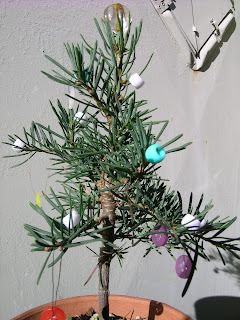
This cute little tree, decorated for the holidays, is only about a foot tall. It can reach over 100 feet, but it usually "only" grows 50-75 feet. This is White Fir, which is native to California, areas north into Canada and east into Idaho, Nevada, Arizona, New Mexico, and Colorado. It turns into a lovely, dense, formal cone-shaped tree which is commonly used in urban landscapes. It doesn't grow fast, so you don't have to worry about it taking over your space, even though it gets big. Just plant it and let the next generation worry about it! I don't know why it is called White Fir, because is looks kind of bluish. . Maybe because the needles are whitish underneath. Or maybe the wood is white.
It is used for holiday trees, wreaths, and garlands because it holds it needles well and smells great. The wood is soft and knotty, so it is not favored for building. However, as other species become less available, A. concolor has been successfully used for framing houses and making plywood.
This tree has considerable wildlife value. When the trees get old and hollow, many mammals use them to bed down. Weasels, porcupines, black bears, etc. Birds use the snags are for roosting and nesting and the seeds are part of their diet. Even though the needles may seem too strong for browsing, deer and other animals eat it, especially the new growth.
These cute trees, decorated with buttons and beads, are for sale and available now on the plant deck at the UC Botanical Garden.

 This plant may be cushion-shaped, but it is not soft. It looks more like a spiny boulder to me. It is also called "rosette forming" and "ground covering" but those descriptions do not do it justice. It is is in the pineapple family (Bromeliaceae) and makes me think of a thousand tiny pineapple tops all cramped together in a mound. It likes bright sun and well-drained soil. Does well in pots. Drought tolerant, but it does appreciate some water and mist. Deer resistant! What deer would want all those spines in its mouth? An easy to grow and unusual plant. Not right for every garden, but a great conversation piece.
This plant may be cushion-shaped, but it is not soft. It looks more like a spiny boulder to me. It is also called "rosette forming" and "ground covering" but those descriptions do not do it justice. It is is in the pineapple family (Bromeliaceae) and makes me think of a thousand tiny pineapple tops all cramped together in a mound. It likes bright sun and well-drained soil. Does well in pots. Drought tolerant, but it does appreciate some water and mist. Deer resistant! What deer would want all those spines in its mouth? An easy to grow and unusual plant. Not right for every garden, but a great conversation piece.









































